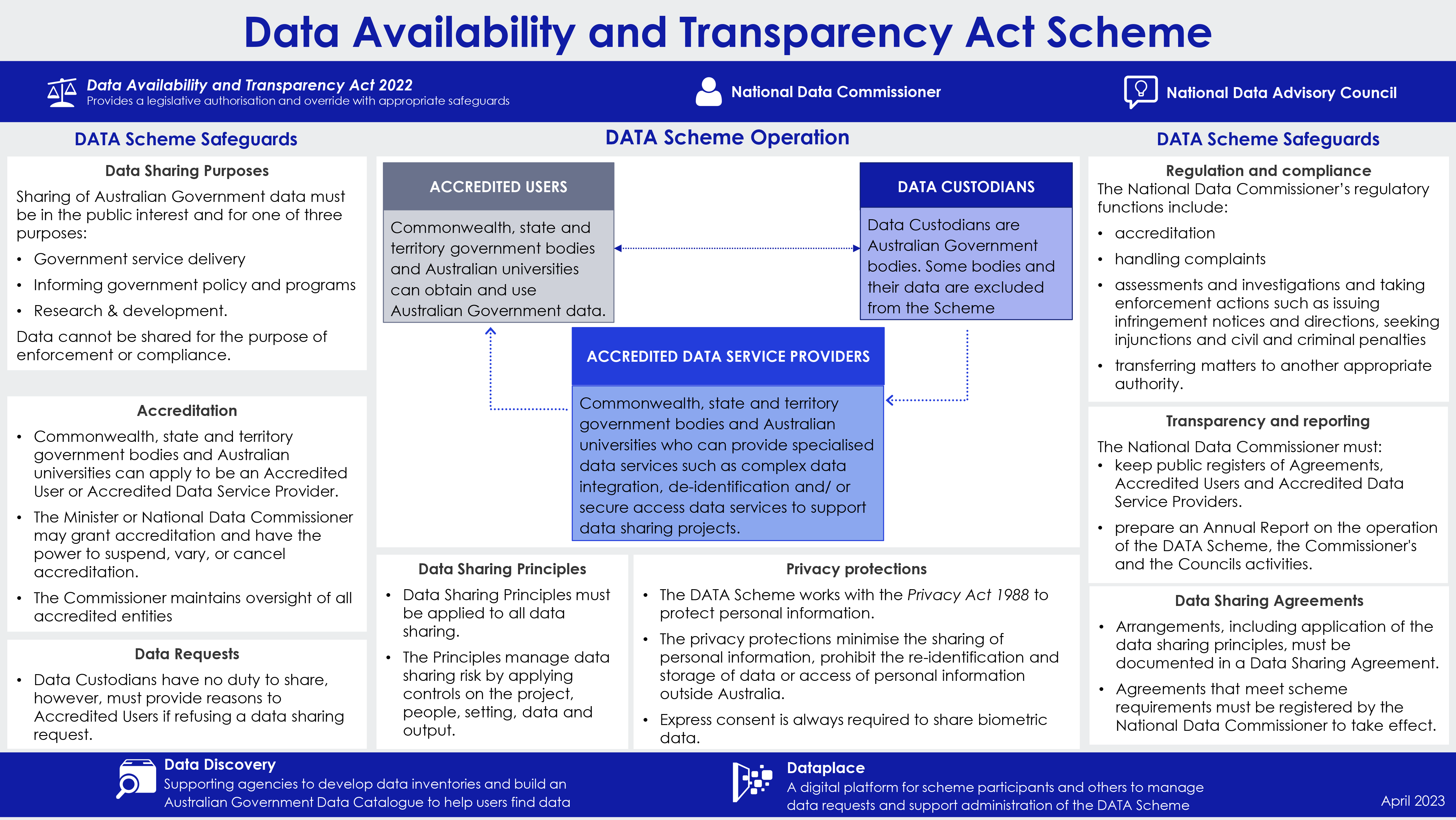A scheme for sharing Australian Government data
The Data Availability and Transparency Act 2022 establishes a new, best practice scheme for sharing Australian Government data – the DATA Scheme. The DATA Scheme is underpinned by strong safeguards and consistent, efficient processes. It is focused on increasing the availability and use of Australian Government data to deliver government services that are simple, effective and respectful, inform better government policies and programs, and support world-leading research and development.
The National Data Commissioner is the regulator of the DATA Scheme and provides advice and guidance about its operation. The National Data Commissioner also delivers education and support for best practice data handling and sharing.
The National Data Advisory Council provides advice on data sharing to the Commissioner on issues such as ethics, balancing data availability with privacy protections, trust and transparency, technical best practice, and industry and international developments.
This information is available for download below or in our Resource Library.

What data can be shared?
Australian Government data encompasses all data lawfully collected, created or held by a Commonwealth body, or on its behalf. Data can include a wide range of topics, from data dealing with the weather, personal and business data, through to freight and traffic movements, and agricultural yields.
For national security and other reasons, some entities are excluded from the Scheme and some types of data cannot be shared. Excluded entities include intelligence and law enforcement entities such as the Australian Federal Police and the Australian Security and Intelligence Organisation. Some data held by Home Affairs and AUSTRAC cannot be shared.
Participants in the DATA Scheme
There are three types of participants in the Scheme.
Data Custodians are Commonwealth Government bodies who control public sector data. Data custodians do not opt-in to the DATA Scheme – they are automatically participants and do not need to apply for this role.
Accredited Users are Commonwealth, state and territory government bodies, and Australian universities who are accredited to obtain and use Australian Government data. Entities must apply to become accredited as a data user.
Accredited Data Service Providers are Commonwealth, state and territory government bodies, and Australian universities. They provide complex data integration, de-identification and secure data access services to support data sharing. Entities must apply to become accredited as a data service provider.
Some entities may be all three types of Scheme participants.
Some Australian Government entities are excluded from participating. Foreign entities are unable to access data under the DATA Scheme.
How does the DATA Scheme operate?
Under the DATA Scheme, Accredited Users can request Australian Government data from a Data Custodian. An Accredited Data Service Provider can be used to provide data services to support the data sharing project.
For example, the New South Wales Department of Health (the Accredited User) can request data from the Commonwealth Department of Social Services (the Data Custodian) and the Australian Bureau of Statistics (the Accredited Data Service Provider) may provide secure access data services to support the sharing.
An Accredited Data Service Provider must be used if the project involves complex data integration.
Authorisation and override
The Act overcomes barriers to data sharing through an authorisation to override Commonwealth, State or Territory laws, that would otherwise prohibit the sharing, collection and use of certain data when appropriate safeguards are in place.
The Act does not override the Privacy Act 1988 and the sharing, collection and use of data under the Scheme must be consistent with the Privacy Act.
Page last updated: 14 April 2023
